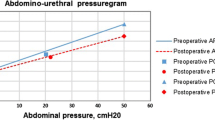Abstract
Introduction and objectives
The resting urethral pressure profile (UPP), used for the assessment of women with stress incontinence, is routine in many urodynamic units. It is time- and effort-consuming, and its diagnostic value is controversial, as well as its value in the prediction of outcome of anti-incontinence surgery. Herein, we assessed its value in the prediction of the outcome of surgery.
Patients and methods
Sixty women were randomized to fascial sling or TVT. Urodynamics were performed preoperatively, 6 months and annually thereafter. After filling and voiding cystometry, resting UPP was performed while sitting. Automated catheter pulling, at a rate of 1 mm/s, was adopted. Averaged readings were obtained. Comparison of maximum urethral closure pressure (MUCP) in success and failure, as well as in sling and TVT, was performed, utilizing ANOVA.
Results
Preoperative MUCP and functional urethral length (FUL) were 72.9 ± 27.9 cmH2O and 2.4 ± 0.7 cm. At last follow-up, they were 71.1 ± 20.7 cmH2O and 2.7 ± 0.7 cm, respectively. The differences between sling and TVT as regards value of MUCP and FUL were not significant. The relationship of the outcome of surgery and UPP parameters showed no statistical difference. No significant effect was shown for the success of surgery, duration of follow-up, and interaction of outcome and time over MUCP (P = 0.82, 0.56 and 0.69, respectively) or FUL (P = 0.82, 0.11 and 0.67, respectively).
Conclusion
The routine use of resting UPP has no added value in terms of the prediction of success of incontinence surgery. It does not help with follow-up and adds to the time and cost of the examination.
Similar content being viewed by others
Abbreviations
- UPP:
-
Urethral pressure profile
- SUI:
-
Stress urinary incontinence
- ICS:
-
International continence Society
- LPP:
-
Leak point pressure
- MUCP:
-
Maximum urethral closure pressure
- FUL:
-
Functional urethral length
- TVT:
-
Tension-free vaginal tape
- ANOVA:
-
Analysis of variance
- BOO:
-
Bladder outlet obstruction
References
Bates P, Bradley W, Melchior H, Rowan D, Sterling A, Hald T (1976) First report on the standardization of terminology of lower urinary tract function. Br J Urol 48:39–42
Abrams P, Blaivas J, Stanton S, Andersen JT (1988) The standardization of terminology of lower urinary tract function. Scand J Urol Nephrol Suppl 114:5–19
Abrams P (1979) Perfusion urethral profilometry. Urol Clin North Am 6:103–110
Abrams P, Cardozo L, Fall M, Griffiths D, Rosier P, Ulmsten U et al (2002) The standardisation of terminology of lower urinary tract function: report from the Standardisation Subcommittee of the International Continence Society. Neurourol Urodyn 21:167–178
Susset J, Plante P (1980) Studies of female urethral pressure profile. Part II. Urethral pressure profile in female incontinence. J Urol 123(1):70–74
Awad SA, Bryniak SR, Lowe PJ, Bruce AW, Twiddy DA (1978) Urethral pressure profile in female stress incontinence. J Urol 120(4):475–479
Hendriksson L, Andersson KE, Ulmsten U (1979) The urethral pressure profiles in continent and stress-incontinent women. Scand J Urol Nephrol 13(1):5–10
Versi E (1990) Discriminant analysis of urethral pressure profilometry data for the diagnosis of genuine stress incontinence. Br J Obstet Gynaecol 97(3):251–259
Lose G (1997) Urethral pressure measurement. Acta Obstet Gynecol Scand Suppl 166:39–42
Hilton P (1989) A clinical and urodynamic study comparing the Stamey bladder neck suspension and suburethral sling procedures in the treatment of genuine stress incontinence. Br J Obstet Gynaecol 96(2):213–220
Koelle D, Windisch J, Doerfler D, Marth C, Kropshofer S (2006) Effect of tension-free vaginal tape operation on urethral closure function. Urology 67(3):524–528. doi:10.1016/j.urology.2005.09.063
Lo TS, Horng SG, Chang CL, Huang HJ, Tseng LH, Liang CC (2002) Tension-free vaginal tape procedure after previous failure in incontinence surgery. Urology 60(1):57–61. doi:10.1016/S0090-4295(02)01618-7
Author information
Authors and Affiliations
Corresponding author
Rights and permissions
About this article
Cite this article
Wadie, B.S., El-Hefnawy, A.S. Urethral pressure measurement in stress incontinence: does it help?. Int Urol Nephrol 41, 491–495 (2009). https://doi.org/10.1007/s11255-008-9506-9
Received:
Accepted:
Published:
Issue Date:
DOI: https://doi.org/10.1007/s11255-008-9506-9




